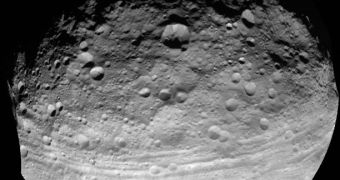Investigators at the Johns Hopkins University (JHU) Applied Physics Laboratory (APL) in Laurel, Maryland, say in a new study that the asteroid Vesta, the largest in our solar system, may in fact be much more geologically complex than initially established.
The research paper, published in the latest issue of the American Geophysical Union's (AGU) esteemed journal Geophysical Research Letters, suggests that fault lines may have developed on the asteroid's surface in the distant past.
These conclusions are based on studies of the enormous troughs that have been detected across Vesta's surface. These structures are in fact dropped blocks of terrain that used to be bound by fault lines.
This discovery hints at a type of geological complexity that is very uncommon in asteroids. This is why scientists now believe that the object is in fact a protoplanet whose growth was stopped early on in the history of the solar system.
Experts have been trying to work out the intricate history behind these unusual landscape features for more than a year. The information used in this research was compiled by the NASA Dawn spacecraft, which entered orbit around Vesta on July 16, 2011.
Managed by experts at the NASA Jet Propulsion Laboratory (JPL) in Pasadena, California, the mission returned a wealth of data on the giant asteroid, including images of the mysterious troughs, and evidences that hydrated minerals exist on its surface.
The research team behind the new study was led by APL investigator Debra Buczkowski, the lead author of the study, and a participating scientist with the Dawn mission. She explains that, most likely, Vesta was on its way to develop into a rocky planet, when some natural processes stopped it.
Even though Dawn departed the asteroid a few weeks ago, it managed to relay sufficient amounts of data back to Earth to keep scientists going for several more years. A careful analysis of available information will help experts figure out what actually happened.
The NASA orbiter is currently en route to the dwarf planet Ceres, which it will reach in February 2015. Both Vesta and Ceres are located inside the Inner Asteroid Belt, between the orbits of Mars and Jupiter.
Dawn is the first NASA mission to attempt to enter orbit around two celestial bodies in the solar system.

 14 DAY TRIAL //
14 DAY TRIAL //